The AMD Radeon VII Review: An Unexpected Shot At The High-End
by Nate Oh on February 7, 2019 9:00 AM ESTProfessional Visualization and Rendering
With AMD strongly pushing the Radeon VII as a prosumer content creation card, it behooves us to look at rendering, CAD, and professional visualization performance. However, accurate and applicable benchmarks for this field are not so easy to find, especially since performance is highly dependent on workflow and proprietary licensed ISV software. Given AnandTech’s audience, which often includes engineers using these applications in critical production environments, our goal is to provide the most relevant metrics. However, as Ian has discussed previously, the route to the most accurate workstation benchmarking for professional applications is in the hands of ISVs, who are at best blasé and more typically negative about providing access, even at the prospect of lending limited software licenses in return for ongoing discussion and third-party benchmark data of their software.
Those caveats in mind, the next best thing for evaluating overall GPU workstation performance is the venerable SPECviewperf, recently updated to version 13. Separated into ‘viewsets,’ which are a group of application-specific workloads derived from real-world datasets, SPECviewperf has been a longstanding suite for generalized workstation/CAD GPU performance. For SPECviewperf 13, the viewsets are based on:
- Autodesk 3ds Max 2016 (Nitrous DX11 driver)
- Dassault Systèmes CATIA V6 R2012
- PTC Creo 3 & Creo 4
- Geosurvey software, with workloads based on rendering techniques utilized by the open-source OpendTect seismic visualization application
- Autodesk Maya 2017
- Radiological (i.e. CT, MRI scans) rendering, with workloads using the Tuvok rendering core of the ImageVis3D volume visualization application
- Autodesk Showcase 2013
- Siemens NX 8.0
- Dassault Systèmes Solidworks 2013 SP1
While we didn’t have time for complete benchmarking of video editing/production software such as Adobe Premiere Pro CC, we will be looking to include that in the future.
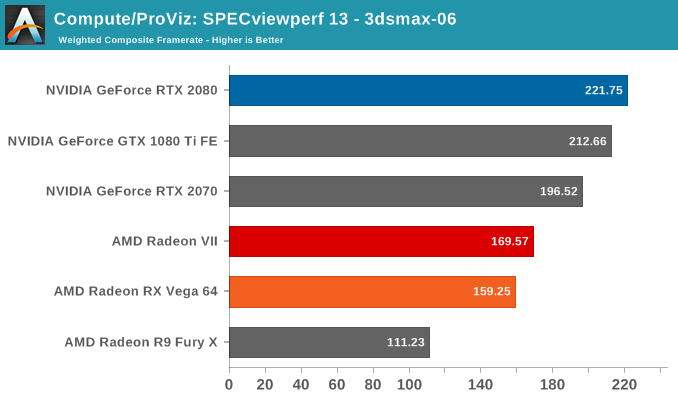
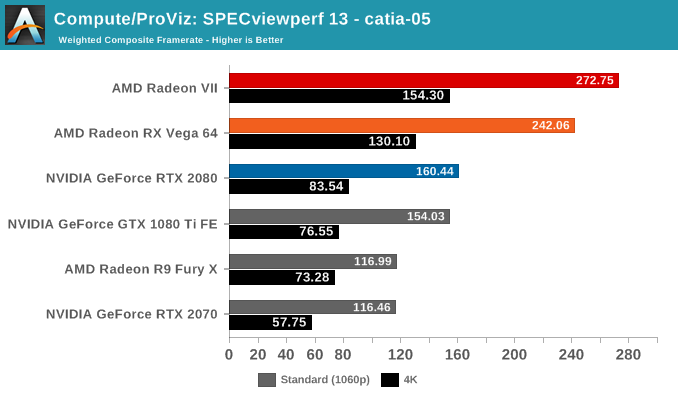

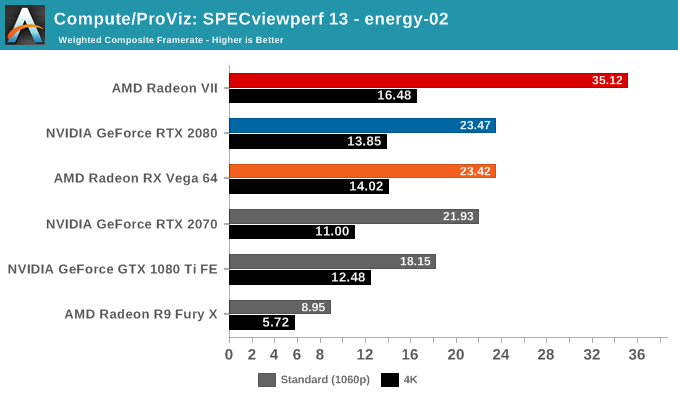
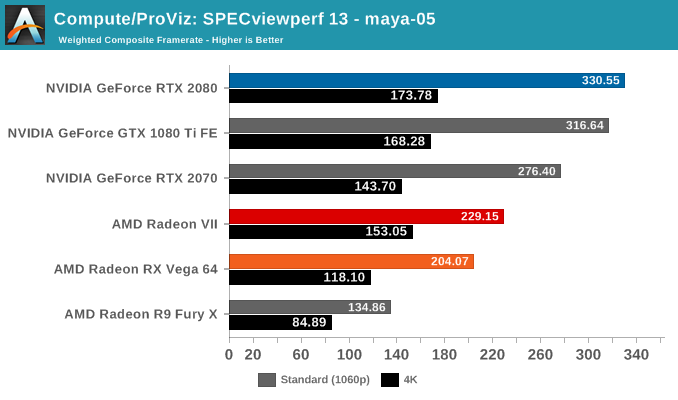
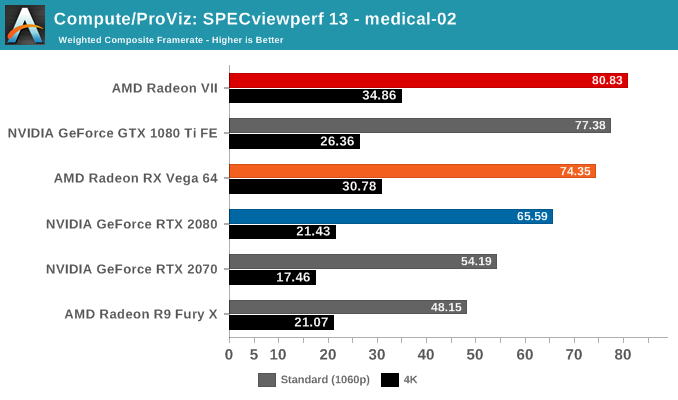
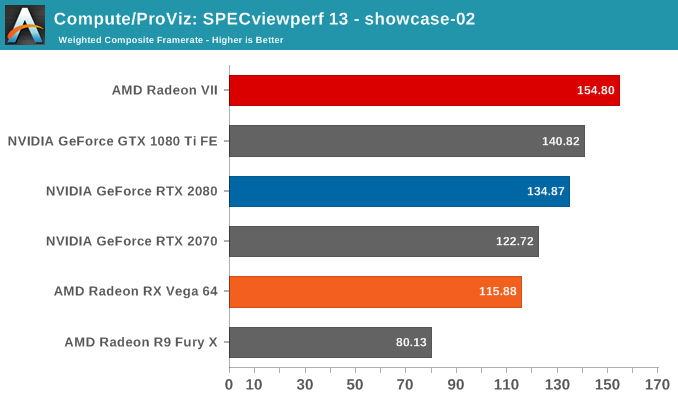
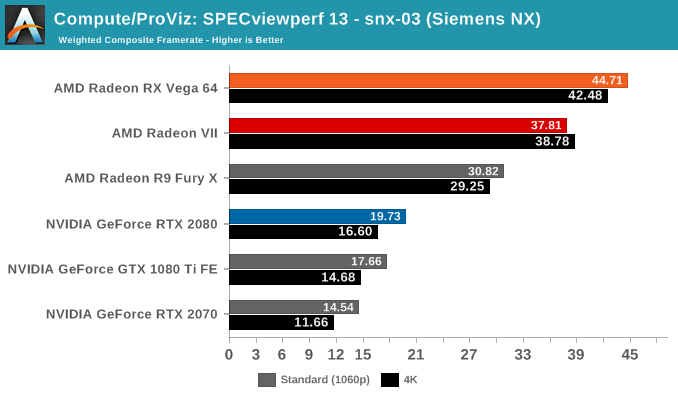
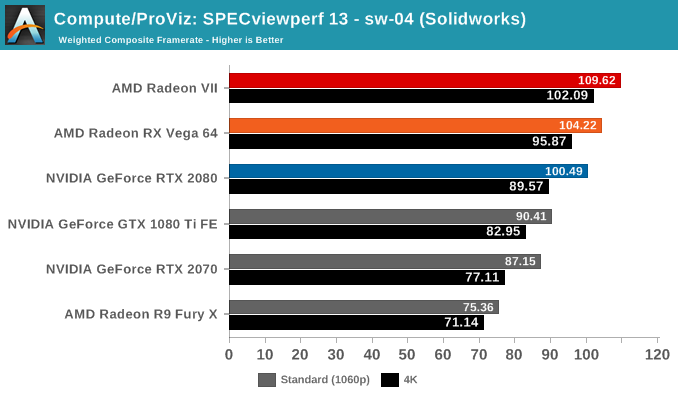
Looking over the results, it's clear that certain viewsets tend to perform better on one vendor's hardware than the other's. In those cases, the Radeon VII doesn't buck the trend, though in Siemens NX the lower performance is more likely than not related to driver maturity. In the reverse scenarios like in creo-02 or maya-05, the Radeon VII is in a similar spot, naturally ahead of the RX Vega 64 but behind the competing RTX and GTX cards. If anything, the results highlight the importance of software maturity for newer hardware, but there are definite signs of Vega 20 being a powerful workstation card. The caveat is that it doesn't seem to change the overall landscape for worksets that traditionally perform well on NVIDIA hardware.
Our next set of benchmarks look at rendering performance. To be clear, given the nature of ‘render wars’ as well as the adoption of CUDA, the featured render engines are not necessarily indicative of the overall GPU renderer landscape. Because we are looking at the Radeon VII, it’s not applicable to include some of the more popular renderers, such as Redshift and Octane, which are CUDA-only, and similarly the presence of Indigo Renderer helps as another datapoint even though it is less popular.


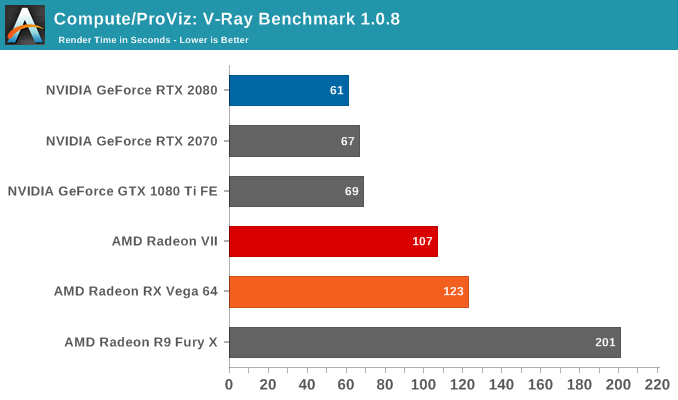

To note, official Blender releases have yet to incorporate CUDA 10, and so RTX 20 series cards are not officially supported.
V-RAY here is the only test that utilizes CUDA for NVIDIA cards, while the rest all use OpenCL. The results seem broadly similar to SPECviewperf, where the Radeon VII continues to excel at workloads where AMD hardware generally fare well.










289 Comments
View All Comments
PeachNCream - Thursday, February 7, 2019 - link
Sorry about that. The Radeon VII is very much out of the range of prices I'm willing to pay for any single component or even an whole system for that matter. I was zinging about the GPU being called high-end (which it rightfully is) because in another recent article, a $750 monitor was referred to as midrange. See:https://www.anandtech.com/show/13926/lg-launches-3...
It was more to make a point about the inconsistency with which AT classifies products than an actual reflection of my own buying habits.
As for my primary laptop, my daily driver is a Bay Trail HP Stream 11 running Linux so yeah, it's packing 2GB of RAM and 32GB of eMMC. I have a couple other laptops around which I use significantly less often that are older, but arguably more powerful. The Stream is just a lot easier to take from place to place.
Korguz - Friday, February 8, 2019 - link
it could be.. that maybe the manufacturer refers it as a mid range product ( the monitor ) in their product stack.. and AT.. just calls it that, because of that ?:-)
eva02langley - Friday, February 8, 2019 - link
I follow you on that. I bought a 1080 TI and I told myself this is the maximum I am willing to put for a GPU.I needed something for 4k and it was the only option. If Navi is 15% faster than Vega 64 for 300$, I am buying one on launch.
D. Lister - Saturday, February 9, 2019 - link
But why would you want to spend $300 for a downgrade from your 1080Ti?HollyDOL - Thursday, February 7, 2019 - link
Purely on gaming field this can't really compete with RTX 2080 (unless some big enough perf change comes with new drivers soon)... it's performing almost same, but at a little bit more power, hotter and almost 10dB louder, which is quite a lot. Given that it won't be able to offer anything more (as oposed to possible adoptions of DXR) I would expect it not trying to compete for same price level RTX 2080 does.If it can get $50-$100 lower otoh, you get what many people asked for... kind of "GTX 2080" ... classic performance without ray tracing and DLSS extensions.
With current price though It only makes sense if they are betting they can get enough compute buyers.
Oxford Guy - Thursday, February 7, 2019 - link
Yeah, because losing your hearing to tinnitus is definitely worth that $50-100.HollyDOL - Friday, February 8, 2019 - link
Well, it's "lab conditions", it can always get dampened with good chasis or chasis position to reasonable levels and hopefully noone should be playing with head stuck inside the chasis... For me subjectively it would be too loud, but I wanted to give the card advantage of doubt, non-reference designs should hopefully get to lower levels.Oxford Guy - Friday, February 8, 2019 - link
1) The Nvidia card will be quieter in a chassis. So, that excuse fails.2) I am not seeing significant room for doubt. Fury X was a quiet product (except at idle which some complained about, and in terms of, at least in some cases, coil whine). AMD has chosen to move backward, severely, in the noise department with this product.
This card has a fancy copper vapor chamber with flattened heatpipes and three fans. It also runs hot. So, how is it, at all, rational to expect 3rd-party cards to fix the noise problem? 3rd-party makers typically use 3 slot designs to increase clocks and they typically cost even more.
HollyDOL - Friday, February 8, 2019 - link
Well, not really. If the quieter chassis cuts of enough dB to get it out of disturbing level it will be enough. Also depends on environment... If you play in loud environment (day, loud speakers) the noise won't be percieved as bad as if you play it during night with quiter speakers. Ie. what can be sufferable during day can turn in complete hell during night.That being said I am by any means not advocating +10dB, because it is a lot, but in the end it doesn't have to present so terrible obstacle.
It is very early, there can always be a bug in drivers or bios causing this temp/noise issue or it can be a design problem that cannot be circumvented. But that will be seen only after some time. I remember bug in ForceWare causing my old GTX580 not dropping to 2D frequencies once it kicked in 3D (or was it on 8800GT, I don't really remember)... You had to restart the machine. Such things simply can happen, which doesn't make them any better ofc.
Oxford Guy - Friday, February 8, 2019 - link
"If the quieter chassis cuts of enough dB to get it out of disturbing level it will be enough."Nope. I've owned the Antec P180. I have extensively modified cases and worked hard with placement to reduce noise.
Your argument that the noise can simply be eliminated by putting it into a case is completely bogus. In fact, Silent PC Review showed that more airflow, from less restriction (i.e. a less closed-in case design) can substantially reduce GPU noise — the opposite of the P180 philosophy that Silent PC Review once advocated (and helped to design).
The other problem for your argument is that it is 100% logically true that there is zero reason to purchase an inferior product. Since this GPU is not faster than a 2080 and costs the same there is zero reason to buy a louder GPU, since, in actuality, noise doesn't just get absorbed and disappear when you put it into a case. In fact, this site wrote a review of a Seasonic PSU that could be heard "from rooms away" and I can hear noisy GPUs through walls, too.
"It is very early, there can always be a bug in drivers or bios causing this temp/noise issue"
Then it shouldn't be on the market and shouldn't have been sampled. Alpha quality designs shouldn't be review subjects, particularly when they're being passed off as the full product.